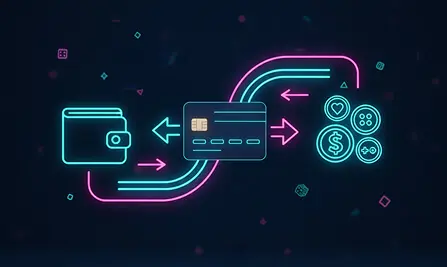What Is P2P Payment?
P2P payments are one of the most popular ways to deposit and withdraw money from exchanges and crypto wallets, which makes many people have questions about security and its legality. Let’s understand what the procedure of p2p payments is, what are the options for transferring money to another user, and what risks should be considered.

How P2P works
P2P is a transfer from one person to another directly without an intermediary. P2P payment, short for peer-to-peer or person-to-person payment, refers to a transaction that allows the public to transfer their money to people online using personal bank and credit union accounts or mobile apps. The mechanism is the same as a card-to-card bank transfer.
Person-to-person payments can be made in the same currency or with conversion. The mechanism can be used to buy cryptocurrency. Example of use: you make a transaction with another person. After that, you send funds in the chosen currency to his bank account. After receiving the payment, the other party to the transaction transfers the specified amount in cryptocurrency to you.
Peer-to-peer payments can be used to top up your account at crypto exchanges or bookmakers. In this case, the balance may receive a payment in your currency or the selected cryptocurrency. It all depends on the terms of the transaction.
In order not to search for the participants of the transaction yourself, there are special programmes on which you can choose payment solutions using P2P. The most popular P2P payment services include:
- PayPal;
- Apple Pay;
- Venmo;
- Cash App;
- Google Pay;
- Square Cash.
The number of services that help in sending money to other users is constantly growing. This is due to the fact that more and more people are abandoning cash in favour of electronic money. It has become more convenient to use bank cards, wallets, crypto wallets to pay for services in ordinary life.
How to make a P2P payment
All P2P platforms look like noticeboards. It can be a separate section on the exchange, or a separate application that performs financial transfers. To make a payment you need to have an account in one of the platforms.
The ability to make transfers may be limited if you have not been identified, so it is important to study the rules of the exchange before you create an account. To verify your account, you may be asked to provide proof of personal data.
On the exchange, you can act as a maker or taker. The first ones create the offer themselves, i.e. they set up the rate, volumes and means of payment. Takers select those offers that are already on the site. They can make a payment faster, as they don’t have to register a transaction, just choose the right rate.
In addition to large P2P platforms, there are private exchangers. They place offers on their websites, apps or Telegram bots. Everything is even easier with them. You just choose what you want to buy and what you want to sell. After that, the exchange and confirmation takes place.
Risks of using P2P
P2P trading is a risky field, so it’s important to know the basic principles of defence against fraudsters. As in other areas where there is a large turnover of funds, there is no 100% guarantee, but there are rules, the implementation of which will reduce the risks to a minimum.
Basic rules of safe transactions:
- choosing a proven platform;
- studying the percentage of successful transactions;
- checking the date of registration of the counterparty and verification;
- receiving and sending transfers only to the details specified by your counterparty;
- conducting the transaction and communicating only within the platform, you cannot go to Telegram or other messengers.
If the fraudulent transaction could not be avoided, then be sure to contact the support service of the exchange or exchanger. It is mandatory to open a dispute on the transaction, this will help to block the transfer.
If you choose an intermediary for the transaction outside the exchange or exchange offices, there is no guarantee and protection from fraud. Once you have sent money, it is impossible to return the transfer. If it is a fraudster, you will lose all your funds. You should not choose risky operations, even if they are noticeably more favourable in terms of the exchange rate. It is better to lose some funds due to a less favourable exchange rate, but be safe from fraud.
Why use P2P
P2P transfers allow you to solve several tasks that are not available when using bank cards or e-wallets. Some users use this solution to bypass the blocking of traditional transfers. Some countries prohibit transfers to customers from other regions. In this case, using P2P allows you to make a transfer to friends, relatives or to pay for services.
With the help of P2P you can top up your balance in a bookmaker’s office, cryptocurrency exchange, online casino, if traditional deposit methods do not work and there is no possibility to make a payment through a cryptocurrency wallet.
Transfers abroad are one of the tasks that can be solved with P2P. The transfer can be subject to lower fees than traditional methods, while there are chances that the money will reach the other user faster.
To sum it all up, P2P solutions help you pay for services and goods, exchange cryptocurrency, transfer money abroad, and save on fees. P2P exchanges are faster and, more often than not, more profitable than other methods.
How you can make money on P2P trading
With the popularity of P2P transfers, the opportunity to make money on transfers has emerged. Arbitrage boils down to finding favourable rates, when you can buy an asset on one platform and sell it on another or on the same platform, and you will find yourself in a plus.
There are two main strategies of P2P arbitrage:
- Intra-exchange. All transactions take place within one platform. The user buys an asset at one price and sells it at a higher price or exchanges the asset for another and sells it.
- Inter-exchange. In this case, several platforms are used. The user buys on one platform, sells on another, and keeps the difference. Profit is formed due to different exchange rates or commissions that are set by the platform.
To successfully earn money on P2P-transfers, you need to have confirmed accounts on several platforms, compare rates, know the exact commissions and find favourable pairs for exchange.
Conclusion
P2P payments are quite popular these days. This popularity is due to the fact that there are no intermediaries in the form of banks and other regulatory bodies when conducting a transaction. It is logical that users quickly appreciated the attractiveness of this payment method.
P2P is used during settlements between people. Such transfers are accepted by some companies. To make a transfer, you can use a mobile application or special services. For such transactions, bank cards and accounts are used. Transactions using wallets are also possible.
The P2P mechanism is also used in the decentralised lending segment. Users lend funds to other customers without mediation with banking systems. The borrower receives the funds promptly and the lender earns on the interest paid by the borrower.
P2p trading has also become widespread. Users buy and sell cryptocurrency on various services. Since the interaction is direct, there is usually no or low trading commission.
Although p2p exchanges cannot yet match centralised marketplaces, these services are still growing in popularity. Services that implement this payment mechanism have great potential as they expand the opportunity to receive funds.
In p2p trading, it is very important to take precautions because if you make a mistake, you can lose your funds. It is important to choose reliable platforms and interact with users who inspire trust. Be sure to pay attention to the reviews of the platform, verification rules, the rating of the counterparty and its date of registration on the platform.
FAQ
What do p2p card-to-card transfers mean?
P2P (peer-to-peer) card-to-card transfers is the process of transferring funds between two bank cards without the involvement of a bank. This means that the transaction is carried out by two individuals using special applications or services for money transfers, such as PayPal.
To make a card-to-card transfer, you need to specify the number of the card to which you plan to send funds, as well as the country, currency and amount. Once the transaction is confirmed, the funds will be transferred to the other user’s account.
What does p2p transfer mean?
A P2P (peer to peer) transfer is a money transfer process that can be done without the involvement of a bank. SWIFT and other systems are not used for transfers. Unlike standard transfers, P2P transfers have lower fees and the transactions themselves are cheaper and processed faster.
The most popular and favourable services using P2P technology are PaySend and Wise.
What is the commission for p2p transfers?
There is no fixed parameter, as the size of the commission depends on the service and provider that uses p2p transfer technology.
In international money transfers, in addition to the commission, you should also pay attention to the exchange rate, as sometimes the lack of commission can be covered by the exchange rate margin. To find the most favourable operator for transfers, you can use services that compare the conditions of providers.
What is a p2p wallet?
Bank cards and accounts are used for settlements using p2p services. In addition to them, you can use a p2p wallet, to which several payment methods are connected.








